Brand Management Report: Lidl's Brand Strategies and Market Analysis
VerifiedAdded on 2022/12/29
|16
|5868
|94
Report
AI Summary
This report delves into the intricacies of brand management, using Lidl Stiftung & Co.KG as a case study. It begins with an introduction to brand management, emphasizing its importance in enhancing brand recognition and customer base growth. The report examines the emergence of branding as a crucial marketing tool, exploring techniques like brand recognition and sales enhancement. It then evaluates successful brand management strategies over time, highlighting the application of relevant theories and models. The core of the report focuses on the components of a successful brand strategy, including brand purpose, vision, values, and target audience. It analyzes different strategies of portfolio management, brand hierarchy, and brand equity management, critically assessing these elements using appropriate frameworks. Furthermore, the report evaluates collaborative brand management approaches at both domestic and global levels, analyzing techniques used to leverage and extend brands. Finally, it explores various techniques for measuring and managing brand value, evaluating their effectiveness in developing a strong and enduring brand. The report concludes with an overall critical evaluation of brand management within an organizational context, providing a comprehensive understanding of the subject.
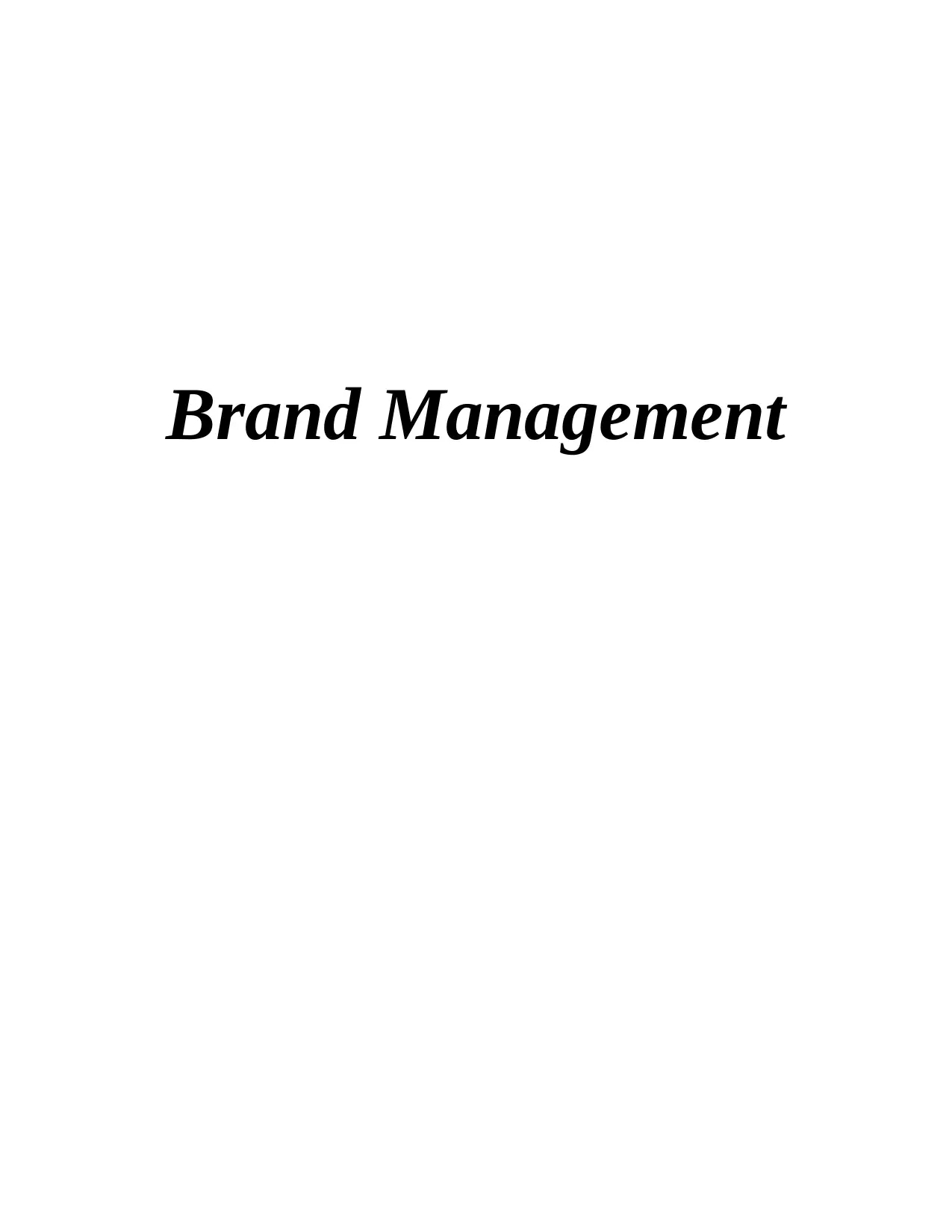
Brand Management
Paraphrase This Document
Need a fresh take? Get an instant paraphrase of this document with our AI Paraphraser
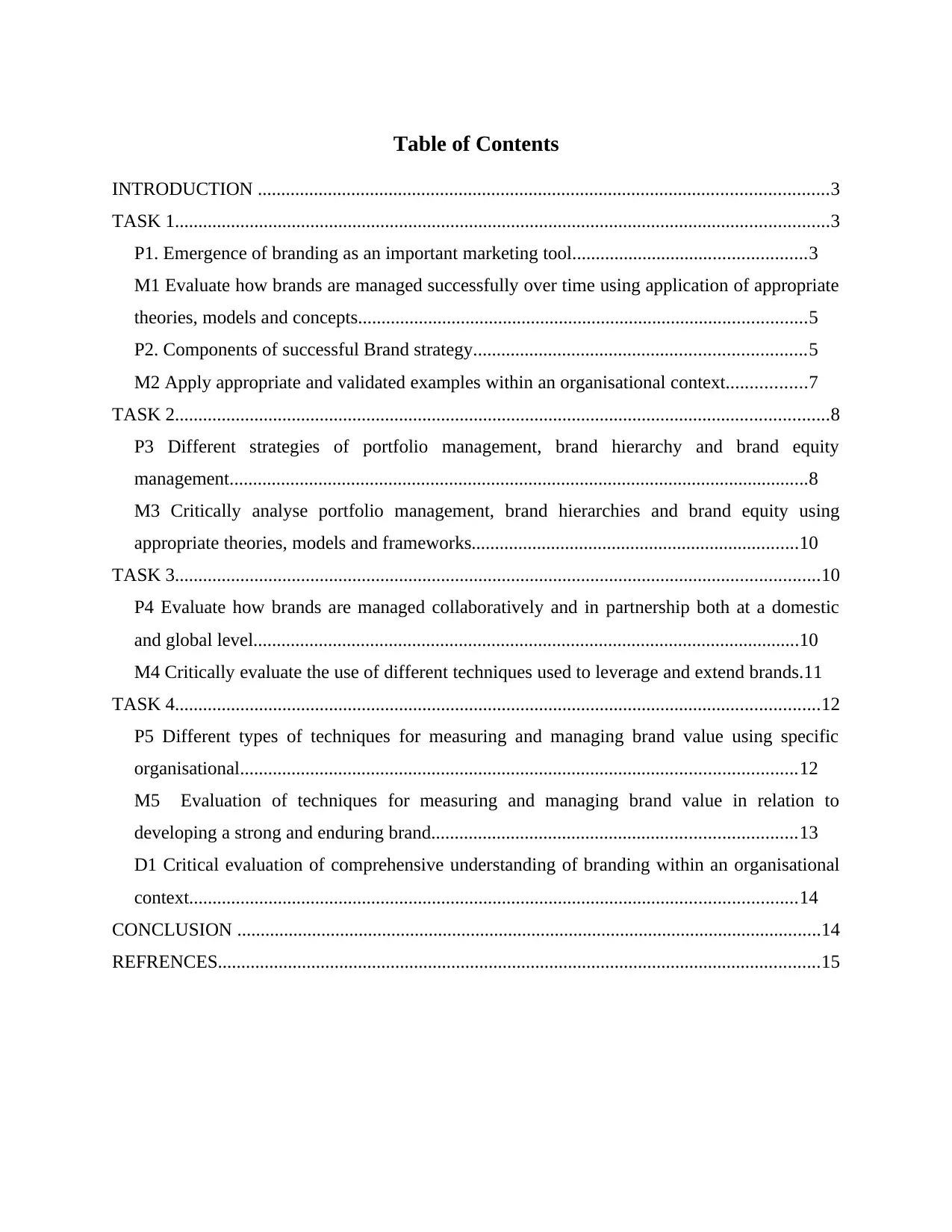
Table of Contents
INTRODUCTION ..........................................................................................................................3
TASK 1............................................................................................................................................3
P1. Emergence of branding as an important marketing tool..................................................3
M1 Evaluate how brands are managed successfully over time using application of appropriate
theories, models and concepts................................................................................................5
P2. Components of successful Brand strategy.......................................................................5
M2 Apply appropriate and validated examples within an organisational context.................7
TASK 2............................................................................................................................................8
P3 Different strategies of portfolio management, brand hierarchy and brand equity
management............................................................................................................................8
M3 Critically analyse portfolio management, brand hierarchies and brand equity using
appropriate theories, models and frameworks......................................................................10
TASK 3..........................................................................................................................................10
P4 Evaluate how brands are managed collaboratively and in partnership both at a domestic
and global level.....................................................................................................................10
M4 Critically evaluate the use of different techniques used to leverage and extend brands.11
TASK 4..........................................................................................................................................12
P5 Different types of techniques for measuring and managing brand value using specific
organisational.......................................................................................................................12
M5 Evaluation of techniques for measuring and managing brand value in relation to
developing a strong and enduring brand..............................................................................13
D1 Critical evaluation of comprehensive understanding of branding within an organisational
context..................................................................................................................................14
CONCLUSION .............................................................................................................................14
REFRENCES.................................................................................................................................15
INTRODUCTION ..........................................................................................................................3
TASK 1............................................................................................................................................3
P1. Emergence of branding as an important marketing tool..................................................3
M1 Evaluate how brands are managed successfully over time using application of appropriate
theories, models and concepts................................................................................................5
P2. Components of successful Brand strategy.......................................................................5
M2 Apply appropriate and validated examples within an organisational context.................7
TASK 2............................................................................................................................................8
P3 Different strategies of portfolio management, brand hierarchy and brand equity
management............................................................................................................................8
M3 Critically analyse portfolio management, brand hierarchies and brand equity using
appropriate theories, models and frameworks......................................................................10
TASK 3..........................................................................................................................................10
P4 Evaluate how brands are managed collaboratively and in partnership both at a domestic
and global level.....................................................................................................................10
M4 Critically evaluate the use of different techniques used to leverage and extend brands.11
TASK 4..........................................................................................................................................12
P5 Different types of techniques for measuring and managing brand value using specific
organisational.......................................................................................................................12
M5 Evaluation of techniques for measuring and managing brand value in relation to
developing a strong and enduring brand..............................................................................13
D1 Critical evaluation of comprehensive understanding of branding within an organisational
context..................................................................................................................................14
CONCLUSION .............................................................................................................................14
REFRENCES.................................................................................................................................15
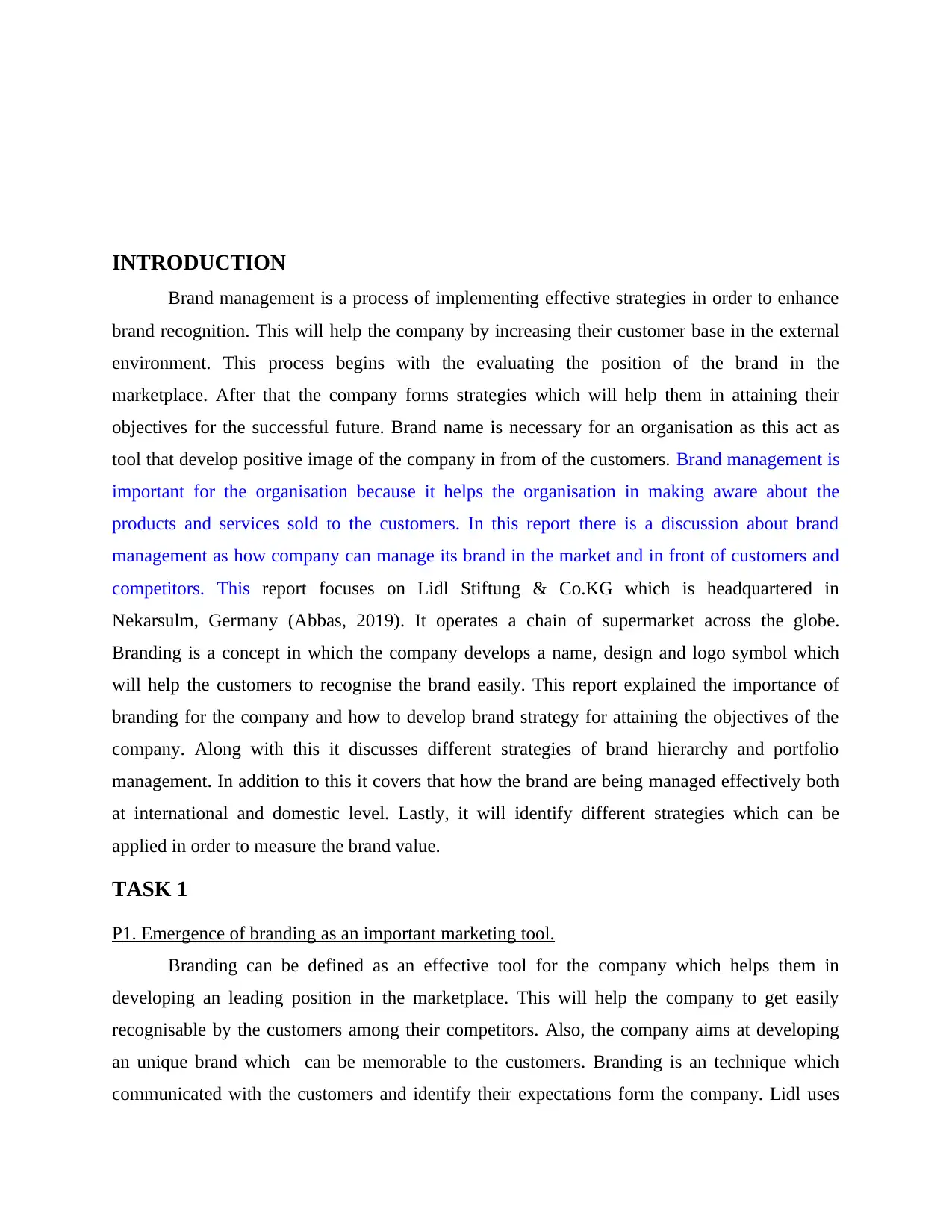
INTRODUCTION
Brand management is a process of implementing effective strategies in order to enhance
brand recognition. This will help the company by increasing their customer base in the external
environment. This process begins with the evaluating the position of the brand in the
marketplace. After that the company forms strategies which will help them in attaining their
objectives for the successful future. Brand name is necessary for an organisation as this act as
tool that develop positive image of the company in from of the customers. Brand management is
important for the organisation because it helps the organisation in making aware about the
products and services sold to the customers. In this report there is a discussion about brand
management as how company can manage its brand in the market and in front of customers and
competitors. This report focuses on Lidl Stiftung & Co.KG which is headquartered in
Nekarsulm, Germany (Abbas, 2019). It operates a chain of supermarket across the globe.
Branding is a concept in which the company develops a name, design and logo symbol which
will help the customers to recognise the brand easily. This report explained the importance of
branding for the company and how to develop brand strategy for attaining the objectives of the
company. Along with this it discusses different strategies of brand hierarchy and portfolio
management. In addition to this it covers that how the brand are being managed effectively both
at international and domestic level. Lastly, it will identify different strategies which can be
applied in order to measure the brand value.
TASK 1
P1. Emergence of branding as an important marketing tool.
Branding can be defined as an effective tool for the company which helps them in
developing an leading position in the marketplace. This will help the company to get easily
recognisable by the customers among their competitors. Also, the company aims at developing
an unique brand which can be memorable to the customers. Branding is an technique which
communicated with the customers and identify their expectations form the company. Lidl uses
Brand management is a process of implementing effective strategies in order to enhance
brand recognition. This will help the company by increasing their customer base in the external
environment. This process begins with the evaluating the position of the brand in the
marketplace. After that the company forms strategies which will help them in attaining their
objectives for the successful future. Brand name is necessary for an organisation as this act as
tool that develop positive image of the company in from of the customers. Brand management is
important for the organisation because it helps the organisation in making aware about the
products and services sold to the customers. In this report there is a discussion about brand
management as how company can manage its brand in the market and in front of customers and
competitors. This report focuses on Lidl Stiftung & Co.KG which is headquartered in
Nekarsulm, Germany (Abbas, 2019). It operates a chain of supermarket across the globe.
Branding is a concept in which the company develops a name, design and logo symbol which
will help the customers to recognise the brand easily. This report explained the importance of
branding for the company and how to develop brand strategy for attaining the objectives of the
company. Along with this it discusses different strategies of brand hierarchy and portfolio
management. In addition to this it covers that how the brand are being managed effectively both
at international and domestic level. Lastly, it will identify different strategies which can be
applied in order to measure the brand value.
TASK 1
P1. Emergence of branding as an important marketing tool.
Branding can be defined as an effective tool for the company which helps them in
developing an leading position in the marketplace. This will help the company to get easily
recognisable by the customers among their competitors. Also, the company aims at developing
an unique brand which can be memorable to the customers. Branding is an technique which
communicated with the customers and identify their expectations form the company. Lidl uses
⊘ This is a preview!⊘
Do you want full access?
Subscribe today to unlock all pages.

Trusted by 1+ million students worldwide
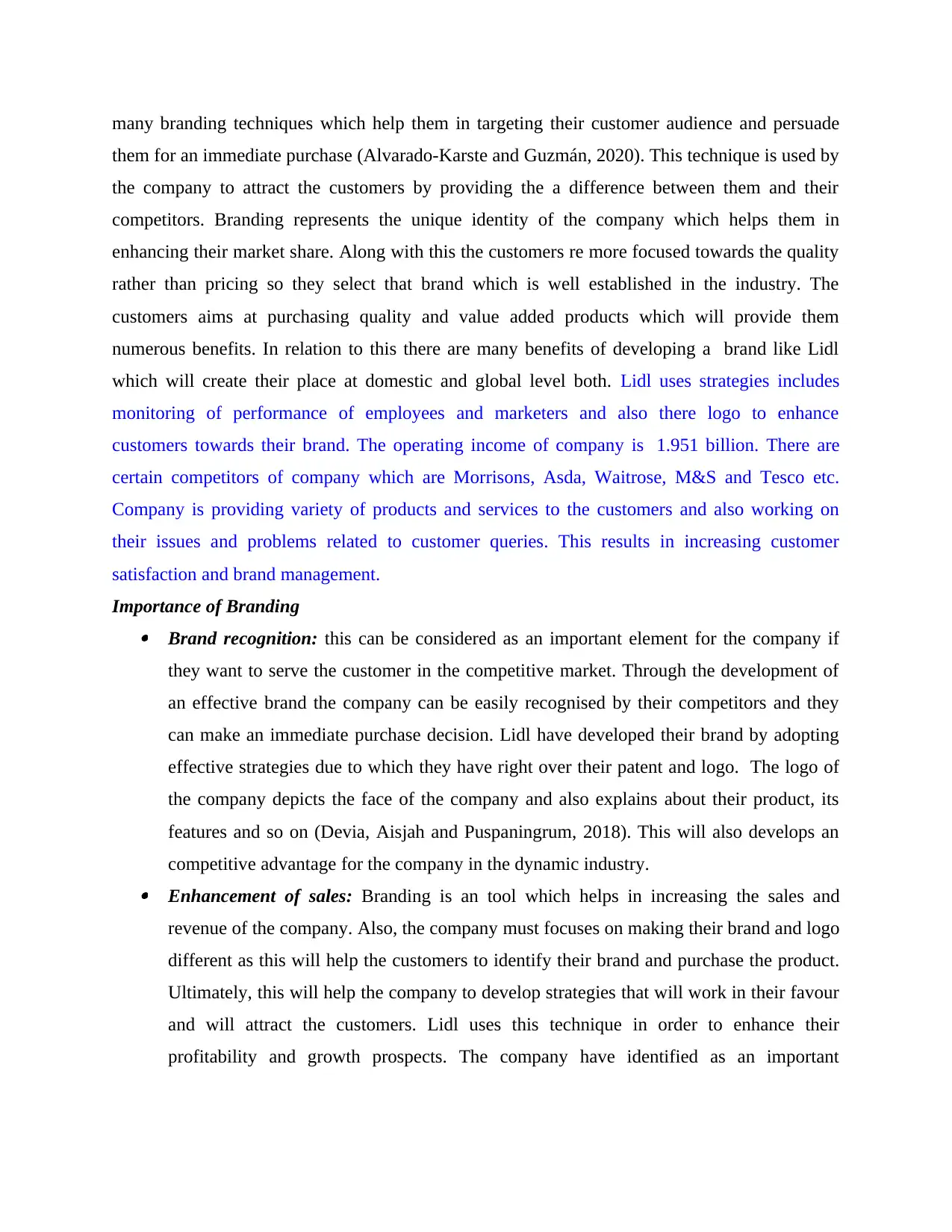
many branding techniques which help them in targeting their customer audience and persuade
them for an immediate purchase (Alvarado-Karste and Guzmán, 2020). This technique is used by
the company to attract the customers by providing the a difference between them and their
competitors. Branding represents the unique identity of the company which helps them in
enhancing their market share. Along with this the customers re more focused towards the quality
rather than pricing so they select that brand which is well established in the industry. The
customers aims at purchasing quality and value added products which will provide them
numerous benefits. In relation to this there are many benefits of developing a brand like Lidl
which will create their place at domestic and global level both. Lidl uses strategies includes
monitoring of performance of employees and marketers and also there logo to enhance
customers towards their brand. The operating income of company is 1.951 billion. There are
certain competitors of company which are Morrisons, Asda, Waitrose, M&S and Tesco etc.
Company is providing variety of products and services to the customers and also working on
their issues and problems related to customer queries. This results in increasing customer
satisfaction and brand management.
Importance of Branding Brand recognition: this can be considered as an important element for the company if
they want to serve the customer in the competitive market. Through the development of
an effective brand the company can be easily recognised by their competitors and they
can make an immediate purchase decision. Lidl have developed their brand by adopting
effective strategies due to which they have right over their patent and logo. The logo of
the company depicts the face of the company and also explains about their product, its
features and so on (Devia, Aisjah and Puspaningrum, 2018). This will also develops an
competitive advantage for the company in the dynamic industry. Enhancement of sales: Branding is an tool which helps in increasing the sales and
revenue of the company. Also, the company must focuses on making their brand and logo
different as this will help the customers to identify their brand and purchase the product.
Ultimately, this will help the company to develop strategies that will work in their favour
and will attract the customers. Lidl uses this technique in order to enhance their
profitability and growth prospects. The company have identified as an important
them for an immediate purchase (Alvarado-Karste and Guzmán, 2020). This technique is used by
the company to attract the customers by providing the a difference between them and their
competitors. Branding represents the unique identity of the company which helps them in
enhancing their market share. Along with this the customers re more focused towards the quality
rather than pricing so they select that brand which is well established in the industry. The
customers aims at purchasing quality and value added products which will provide them
numerous benefits. In relation to this there are many benefits of developing a brand like Lidl
which will create their place at domestic and global level both. Lidl uses strategies includes
monitoring of performance of employees and marketers and also there logo to enhance
customers towards their brand. The operating income of company is 1.951 billion. There are
certain competitors of company which are Morrisons, Asda, Waitrose, M&S and Tesco etc.
Company is providing variety of products and services to the customers and also working on
their issues and problems related to customer queries. This results in increasing customer
satisfaction and brand management.
Importance of Branding Brand recognition: this can be considered as an important element for the company if
they want to serve the customer in the competitive market. Through the development of
an effective brand the company can be easily recognised by their competitors and they
can make an immediate purchase decision. Lidl have developed their brand by adopting
effective strategies due to which they have right over their patent and logo. The logo of
the company depicts the face of the company and also explains about their product, its
features and so on (Devia, Aisjah and Puspaningrum, 2018). This will also develops an
competitive advantage for the company in the dynamic industry. Enhancement of sales: Branding is an tool which helps in increasing the sales and
revenue of the company. Also, the company must focuses on making their brand and logo
different as this will help the customers to identify their brand and purchase the product.
Ultimately, this will help the company to develop strategies that will work in their favour
and will attract the customers. Lidl uses this technique in order to enhance their
profitability and growth prospects. The company have identified as an important
Paraphrase This Document
Need a fresh take? Get an instant paraphrase of this document with our AI Paraphraser
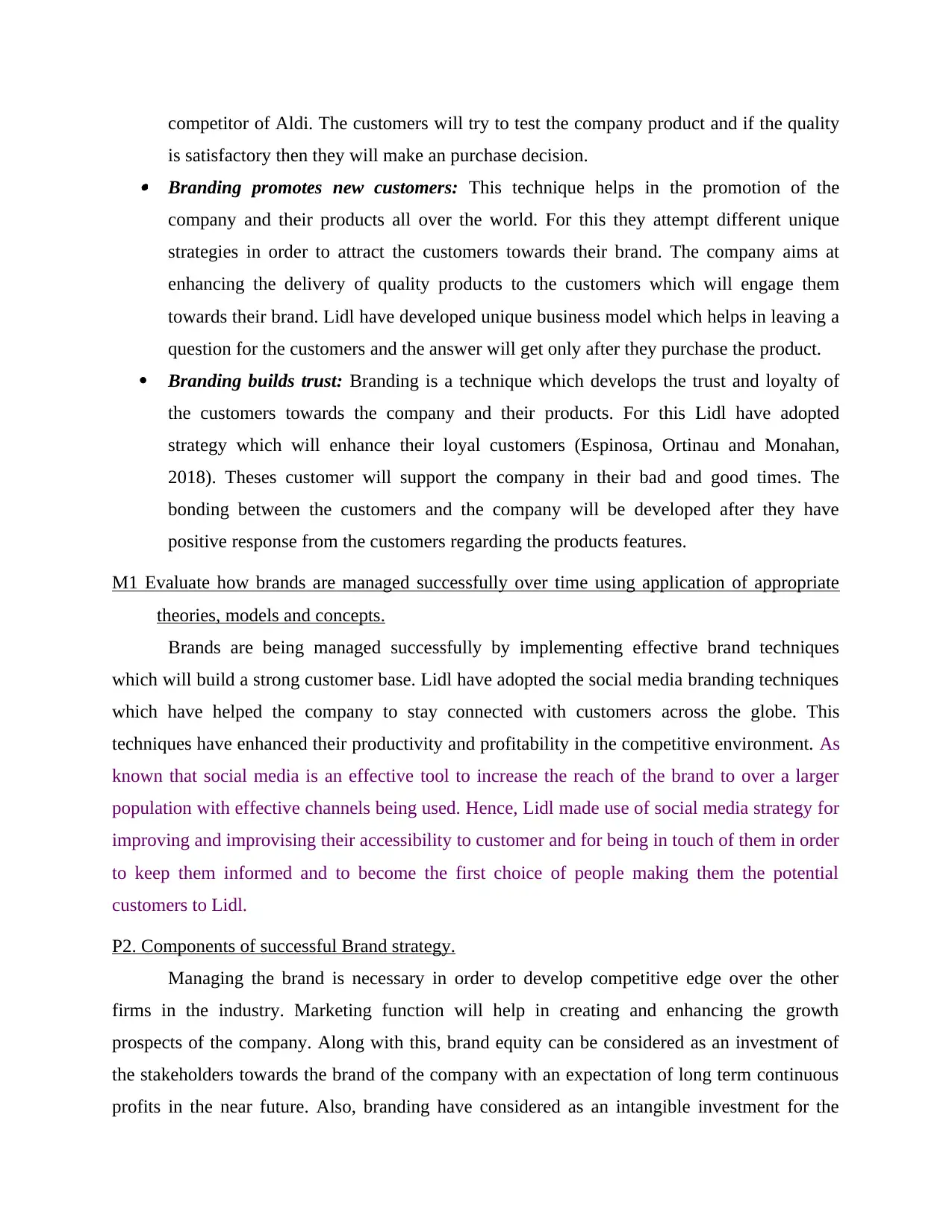
competitor of Aldi. The customers will try to test the company product and if the quality
is satisfactory then they will make an purchase decision. Branding promotes new customers: This technique helps in the promotion of the
company and their products all over the world. For this they attempt different unique
strategies in order to attract the customers towards their brand. The company aims at
enhancing the delivery of quality products to the customers which will engage them
towards their brand. Lidl have developed unique business model which helps in leaving a
question for the customers and the answer will get only after they purchase the product.
Branding builds trust: Branding is a technique which develops the trust and loyalty of
the customers towards the company and their products. For this Lidl have adopted
strategy which will enhance their loyal customers (Espinosa, Ortinau and Monahan,
2018). Theses customer will support the company in their bad and good times. The
bonding between the customers and the company will be developed after they have
positive response from the customers regarding the products features.
M1 Evaluate how brands are managed successfully over time using application of appropriate
theories, models and concepts.
Brands are being managed successfully by implementing effective brand techniques
which will build a strong customer base. Lidl have adopted the social media branding techniques
which have helped the company to stay connected with customers across the globe. This
techniques have enhanced their productivity and profitability in the competitive environment. As
known that social media is an effective tool to increase the reach of the brand to over a larger
population with effective channels being used. Hence, Lidl made use of social media strategy for
improving and improvising their accessibility to customer and for being in touch of them in order
to keep them informed and to become the first choice of people making them the potential
customers to Lidl.
P2. Components of successful Brand strategy.
Managing the brand is necessary in order to develop competitive edge over the other
firms in the industry. Marketing function will help in creating and enhancing the growth
prospects of the company. Along with this, brand equity can be considered as an investment of
the stakeholders towards the brand of the company with an expectation of long term continuous
profits in the near future. Also, branding have considered as an intangible investment for the
is satisfactory then they will make an purchase decision. Branding promotes new customers: This technique helps in the promotion of the
company and their products all over the world. For this they attempt different unique
strategies in order to attract the customers towards their brand. The company aims at
enhancing the delivery of quality products to the customers which will engage them
towards their brand. Lidl have developed unique business model which helps in leaving a
question for the customers and the answer will get only after they purchase the product.
Branding builds trust: Branding is a technique which develops the trust and loyalty of
the customers towards the company and their products. For this Lidl have adopted
strategy which will enhance their loyal customers (Espinosa, Ortinau and Monahan,
2018). Theses customer will support the company in their bad and good times. The
bonding between the customers and the company will be developed after they have
positive response from the customers regarding the products features.
M1 Evaluate how brands are managed successfully over time using application of appropriate
theories, models and concepts.
Brands are being managed successfully by implementing effective brand techniques
which will build a strong customer base. Lidl have adopted the social media branding techniques
which have helped the company to stay connected with customers across the globe. This
techniques have enhanced their productivity and profitability in the competitive environment. As
known that social media is an effective tool to increase the reach of the brand to over a larger
population with effective channels being used. Hence, Lidl made use of social media strategy for
improving and improvising their accessibility to customer and for being in touch of them in order
to keep them informed and to become the first choice of people making them the potential
customers to Lidl.
P2. Components of successful Brand strategy.
Managing the brand is necessary in order to develop competitive edge over the other
firms in the industry. Marketing function will help in creating and enhancing the growth
prospects of the company. Along with this, brand equity can be considered as an investment of
the stakeholders towards the brand of the company with an expectation of long term continuous
profits in the near future. Also, branding have considered as an intangible investment for the
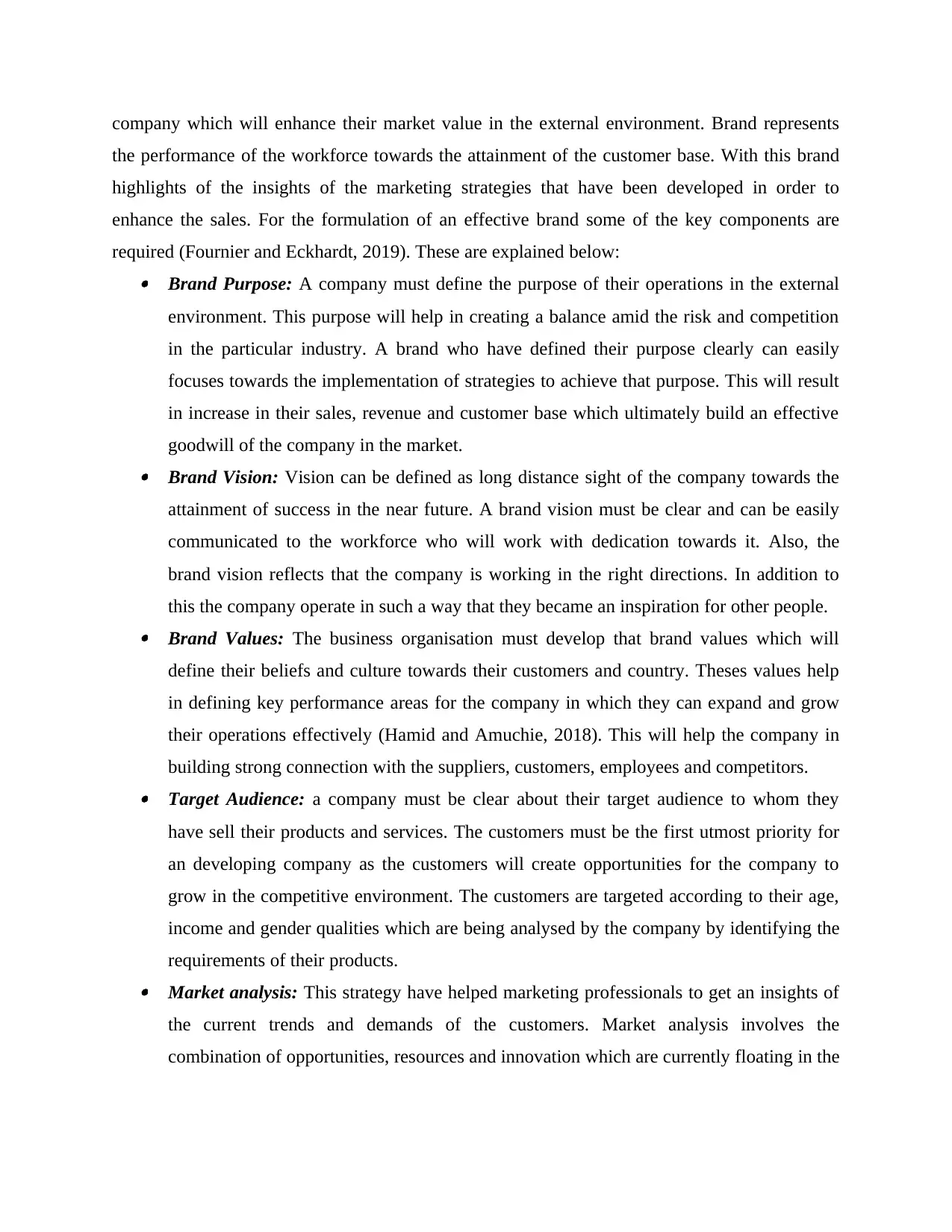
company which will enhance their market value in the external environment. Brand represents
the performance of the workforce towards the attainment of the customer base. With this brand
highlights of the insights of the marketing strategies that have been developed in order to
enhance the sales. For the formulation of an effective brand some of the key components are
required (Fournier and Eckhardt, 2019). These are explained below: Brand Purpose: A company must define the purpose of their operations in the external
environment. This purpose will help in creating a balance amid the risk and competition
in the particular industry. A brand who have defined their purpose clearly can easily
focuses towards the implementation of strategies to achieve that purpose. This will result
in increase in their sales, revenue and customer base which ultimately build an effective
goodwill of the company in the market. Brand Vision: Vision can be defined as long distance sight of the company towards the
attainment of success in the near future. A brand vision must be clear and can be easily
communicated to the workforce who will work with dedication towards it. Also, the
brand vision reflects that the company is working in the right directions. In addition to
this the company operate in such a way that they became an inspiration for other people. Brand Values: The business organisation must develop that brand values which will
define their beliefs and culture towards their customers and country. Theses values help
in defining key performance areas for the company in which they can expand and grow
their operations effectively (Hamid and Amuchie, 2018). This will help the company in
building strong connection with the suppliers, customers, employees and competitors. Target Audience: a company must be clear about their target audience to whom they
have sell their products and services. The customers must be the first utmost priority for
an developing company as the customers will create opportunities for the company to
grow in the competitive environment. The customers are targeted according to their age,
income and gender qualities which are being analysed by the company by identifying the
requirements of their products. Market analysis: This strategy have helped marketing professionals to get an insights of
the current trends and demands of the customers. Market analysis involves the
combination of opportunities, resources and innovation which are currently floating in the
the performance of the workforce towards the attainment of the customer base. With this brand
highlights of the insights of the marketing strategies that have been developed in order to
enhance the sales. For the formulation of an effective brand some of the key components are
required (Fournier and Eckhardt, 2019). These are explained below: Brand Purpose: A company must define the purpose of their operations in the external
environment. This purpose will help in creating a balance amid the risk and competition
in the particular industry. A brand who have defined their purpose clearly can easily
focuses towards the implementation of strategies to achieve that purpose. This will result
in increase in their sales, revenue and customer base which ultimately build an effective
goodwill of the company in the market. Brand Vision: Vision can be defined as long distance sight of the company towards the
attainment of success in the near future. A brand vision must be clear and can be easily
communicated to the workforce who will work with dedication towards it. Also, the
brand vision reflects that the company is working in the right directions. In addition to
this the company operate in such a way that they became an inspiration for other people. Brand Values: The business organisation must develop that brand values which will
define their beliefs and culture towards their customers and country. Theses values help
in defining key performance areas for the company in which they can expand and grow
their operations effectively (Hamid and Amuchie, 2018). This will help the company in
building strong connection with the suppliers, customers, employees and competitors. Target Audience: a company must be clear about their target audience to whom they
have sell their products and services. The customers must be the first utmost priority for
an developing company as the customers will create opportunities for the company to
grow in the competitive environment. The customers are targeted according to their age,
income and gender qualities which are being analysed by the company by identifying the
requirements of their products. Market analysis: This strategy have helped marketing professionals to get an insights of
the current trends and demands of the customers. Market analysis involves the
combination of opportunities, resources and innovation which are currently floating in the
⊘ This is a preview!⊘
Do you want full access?
Subscribe today to unlock all pages.

Trusted by 1+ million students worldwide
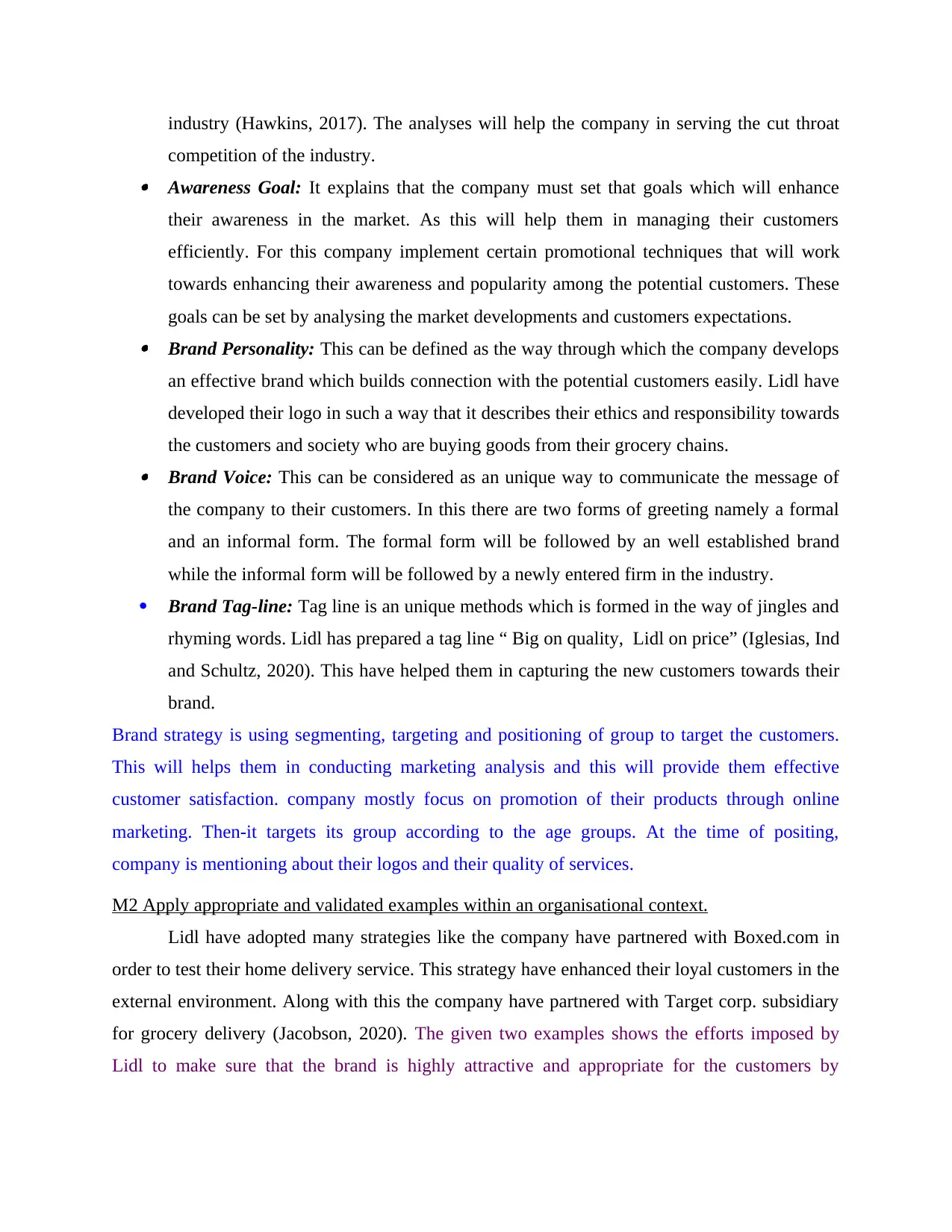
industry (Hawkins, 2017). The analyses will help the company in serving the cut throat
competition of the industry. Awareness Goal: It explains that the company must set that goals which will enhance
their awareness in the market. As this will help them in managing their customers
efficiently. For this company implement certain promotional techniques that will work
towards enhancing their awareness and popularity among the potential customers. These
goals can be set by analysing the market developments and customers expectations. Brand Personality: This can be defined as the way through which the company develops
an effective brand which builds connection with the potential customers easily. Lidl have
developed their logo in such a way that it describes their ethics and responsibility towards
the customers and society who are buying goods from their grocery chains. Brand Voice: This can be considered as an unique way to communicate the message of
the company to their customers. In this there are two forms of greeting namely a formal
and an informal form. The formal form will be followed by an well established brand
while the informal form will be followed by a newly entered firm in the industry.
Brand Tag-line: Tag line is an unique methods which is formed in the way of jingles and
rhyming words. Lidl has prepared a tag line “ Big on quality, Lidl on price” (Iglesias, Ind
and Schultz, 2020). This have helped them in capturing the new customers towards their
brand.
Brand strategy is using segmenting, targeting and positioning of group to target the customers.
This will helps them in conducting marketing analysis and this will provide them effective
customer satisfaction. company mostly focus on promotion of their products through online
marketing. Then-it targets its group according to the age groups. At the time of positing,
company is mentioning about their logos and their quality of services.
M2 Apply appropriate and validated examples within an organisational context.
Lidl have adopted many strategies like the company have partnered with Boxed.com in
order to test their home delivery service. This strategy have enhanced their loyal customers in the
external environment. Along with this the company have partnered with Target corp. subsidiary
for grocery delivery (Jacobson, 2020). The given two examples shows the efforts imposed by
Lidl to make sure that the brand is highly attractive and appropriate for the customers by
competition of the industry. Awareness Goal: It explains that the company must set that goals which will enhance
their awareness in the market. As this will help them in managing their customers
efficiently. For this company implement certain promotional techniques that will work
towards enhancing their awareness and popularity among the potential customers. These
goals can be set by analysing the market developments and customers expectations. Brand Personality: This can be defined as the way through which the company develops
an effective brand which builds connection with the potential customers easily. Lidl have
developed their logo in such a way that it describes their ethics and responsibility towards
the customers and society who are buying goods from their grocery chains. Brand Voice: This can be considered as an unique way to communicate the message of
the company to their customers. In this there are two forms of greeting namely a formal
and an informal form. The formal form will be followed by an well established brand
while the informal form will be followed by a newly entered firm in the industry.
Brand Tag-line: Tag line is an unique methods which is formed in the way of jingles and
rhyming words. Lidl has prepared a tag line “ Big on quality, Lidl on price” (Iglesias, Ind
and Schultz, 2020). This have helped them in capturing the new customers towards their
brand.
Brand strategy is using segmenting, targeting and positioning of group to target the customers.
This will helps them in conducting marketing analysis and this will provide them effective
customer satisfaction. company mostly focus on promotion of their products through online
marketing. Then-it targets its group according to the age groups. At the time of positing,
company is mentioning about their logos and their quality of services.
M2 Apply appropriate and validated examples within an organisational context.
Lidl have adopted many strategies like the company have partnered with Boxed.com in
order to test their home delivery service. This strategy have enhanced their loyal customers in the
external environment. Along with this the company have partnered with Target corp. subsidiary
for grocery delivery (Jacobson, 2020). The given two examples shows the efforts imposed by
Lidl to make sure that the brand is highly attractive and appropriate for the customers by
Paraphrase This Document
Need a fresh take? Get an instant paraphrase of this document with our AI Paraphraser
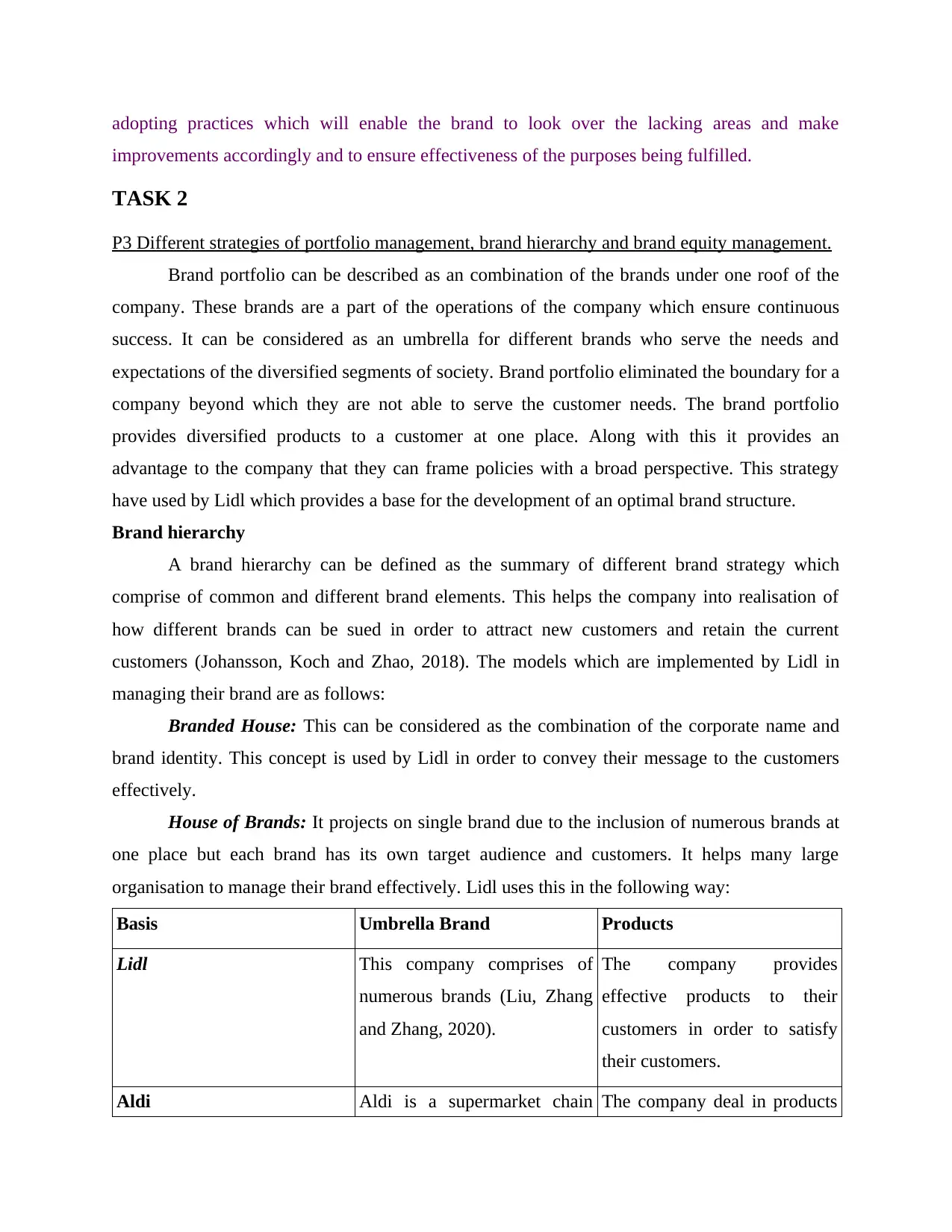
adopting practices which will enable the brand to look over the lacking areas and make
improvements accordingly and to ensure effectiveness of the purposes being fulfilled.
TASK 2
P3 Different strategies of portfolio management, brand hierarchy and brand equity management.
Brand portfolio can be described as an combination of the brands under one roof of the
company. These brands are a part of the operations of the company which ensure continuous
success. It can be considered as an umbrella for different brands who serve the needs and
expectations of the diversified segments of society. Brand portfolio eliminated the boundary for a
company beyond which they are not able to serve the customer needs. The brand portfolio
provides diversified products to a customer at one place. Along with this it provides an
advantage to the company that they can frame policies with a broad perspective. This strategy
have used by Lidl which provides a base for the development of an optimal brand structure.
Brand hierarchy
A brand hierarchy can be defined as the summary of different brand strategy which
comprise of common and different brand elements. This helps the company into realisation of
how different brands can be sued in order to attract new customers and retain the current
customers (Johansson, Koch and Zhao, 2018). The models which are implemented by Lidl in
managing their brand are as follows:
Branded House: This can be considered as the combination of the corporate name and
brand identity. This concept is used by Lidl in order to convey their message to the customers
effectively.
House of Brands: It projects on single brand due to the inclusion of numerous brands at
one place but each brand has its own target audience and customers. It helps many large
organisation to manage their brand effectively. Lidl uses this in the following way:
Basis Umbrella Brand Products
Lidl This company comprises of
numerous brands (Liu, Zhang
and Zhang, 2020).
The company provides
effective products to their
customers in order to satisfy
their customers.
Aldi Aldi is a supermarket chain The company deal in products
improvements accordingly and to ensure effectiveness of the purposes being fulfilled.
TASK 2
P3 Different strategies of portfolio management, brand hierarchy and brand equity management.
Brand portfolio can be described as an combination of the brands under one roof of the
company. These brands are a part of the operations of the company which ensure continuous
success. It can be considered as an umbrella for different brands who serve the needs and
expectations of the diversified segments of society. Brand portfolio eliminated the boundary for a
company beyond which they are not able to serve the customer needs. The brand portfolio
provides diversified products to a customer at one place. Along with this it provides an
advantage to the company that they can frame policies with a broad perspective. This strategy
have used by Lidl which provides a base for the development of an optimal brand structure.
Brand hierarchy
A brand hierarchy can be defined as the summary of different brand strategy which
comprise of common and different brand elements. This helps the company into realisation of
how different brands can be sued in order to attract new customers and retain the current
customers (Johansson, Koch and Zhao, 2018). The models which are implemented by Lidl in
managing their brand are as follows:
Branded House: This can be considered as the combination of the corporate name and
brand identity. This concept is used by Lidl in order to convey their message to the customers
effectively.
House of Brands: It projects on single brand due to the inclusion of numerous brands at
one place but each brand has its own target audience and customers. It helps many large
organisation to manage their brand effectively. Lidl uses this in the following way:
Basis Umbrella Brand Products
Lidl This company comprises of
numerous brands (Liu, Zhang
and Zhang, 2020).
The company provides
effective products to their
customers in order to satisfy
their customers.
Aldi Aldi is a supermarket chain The company deal in products
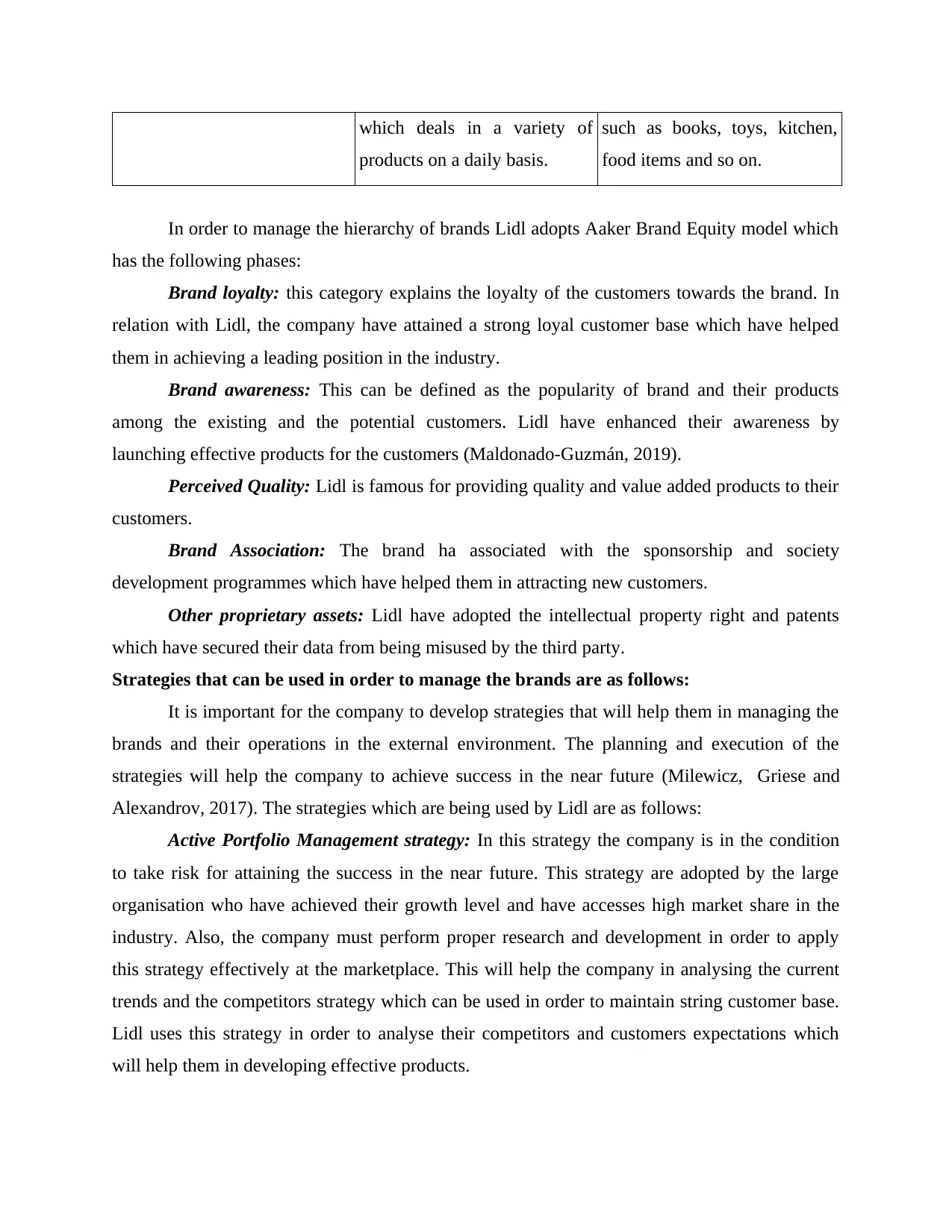
which deals in a variety of
products on a daily basis.
such as books, toys, kitchen,
food items and so on.
In order to manage the hierarchy of brands Lidl adopts Aaker Brand Equity model which
has the following phases:
Brand loyalty: this category explains the loyalty of the customers towards the brand. In
relation with Lidl, the company have attained a strong loyal customer base which have helped
them in achieving a leading position in the industry.
Brand awareness: This can be defined as the popularity of brand and their products
among the existing and the potential customers. Lidl have enhanced their awareness by
launching effective products for the customers (Maldonado-Guzmán, 2019).
Perceived Quality: Lidl is famous for providing quality and value added products to their
customers.
Brand Association: The brand ha associated with the sponsorship and society
development programmes which have helped them in attracting new customers.
Other proprietary assets: Lidl have adopted the intellectual property right and patents
which have secured their data from being misused by the third party.
Strategies that can be used in order to manage the brands are as follows:
It is important for the company to develop strategies that will help them in managing the
brands and their operations in the external environment. The planning and execution of the
strategies will help the company to achieve success in the near future (Milewicz, Griese and
Alexandrov, 2017). The strategies which are being used by Lidl are as follows:
Active Portfolio Management strategy: In this strategy the company is in the condition
to take risk for attaining the success in the near future. This strategy are adopted by the large
organisation who have achieved their growth level and have accesses high market share in the
industry. Also, the company must perform proper research and development in order to apply
this strategy effectively at the marketplace. This will help the company in analysing the current
trends and the competitors strategy which can be used in order to maintain string customer base.
Lidl uses this strategy in order to analyse their competitors and customers expectations which
will help them in developing effective products.
products on a daily basis.
such as books, toys, kitchen,
food items and so on.
In order to manage the hierarchy of brands Lidl adopts Aaker Brand Equity model which
has the following phases:
Brand loyalty: this category explains the loyalty of the customers towards the brand. In
relation with Lidl, the company have attained a strong loyal customer base which have helped
them in achieving a leading position in the industry.
Brand awareness: This can be defined as the popularity of brand and their products
among the existing and the potential customers. Lidl have enhanced their awareness by
launching effective products for the customers (Maldonado-Guzmán, 2019).
Perceived Quality: Lidl is famous for providing quality and value added products to their
customers.
Brand Association: The brand ha associated with the sponsorship and society
development programmes which have helped them in attracting new customers.
Other proprietary assets: Lidl have adopted the intellectual property right and patents
which have secured their data from being misused by the third party.
Strategies that can be used in order to manage the brands are as follows:
It is important for the company to develop strategies that will help them in managing the
brands and their operations in the external environment. The planning and execution of the
strategies will help the company to achieve success in the near future (Milewicz, Griese and
Alexandrov, 2017). The strategies which are being used by Lidl are as follows:
Active Portfolio Management strategy: In this strategy the company is in the condition
to take risk for attaining the success in the near future. This strategy are adopted by the large
organisation who have achieved their growth level and have accesses high market share in the
industry. Also, the company must perform proper research and development in order to apply
this strategy effectively at the marketplace. This will help the company in analysing the current
trends and the competitors strategy which can be used in order to maintain string customer base.
Lidl uses this strategy in order to analyse their competitors and customers expectations which
will help them in developing effective products.
⊘ This is a preview!⊘
Do you want full access?
Subscribe today to unlock all pages.

Trusted by 1+ million students worldwide
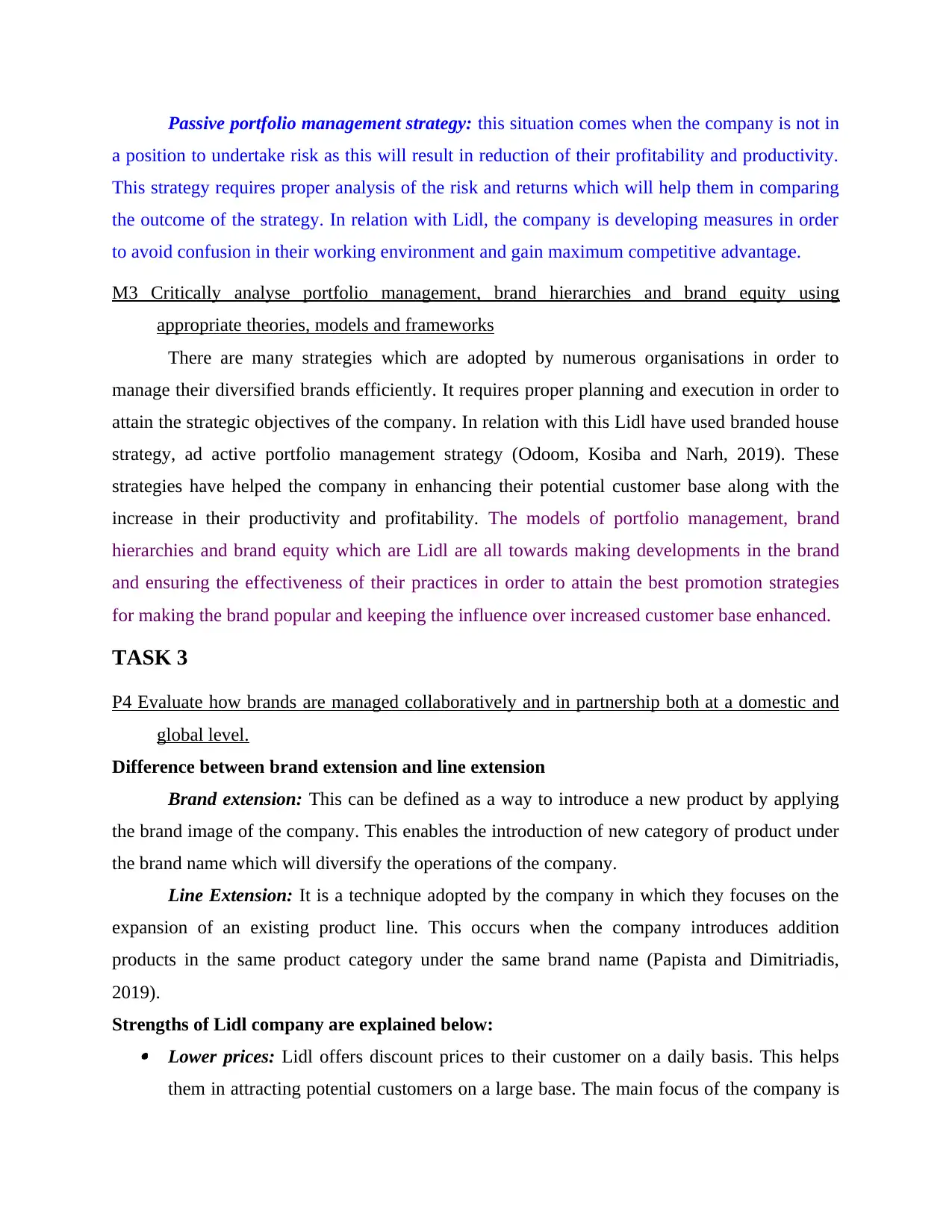
Passive portfolio management strategy: this situation comes when the company is not in
a position to undertake risk as this will result in reduction of their profitability and productivity.
This strategy requires proper analysis of the risk and returns which will help them in comparing
the outcome of the strategy. In relation with Lidl, the company is developing measures in order
to avoid confusion in their working environment and gain maximum competitive advantage.
M3 Critically analyse portfolio management, brand hierarchies and brand equity using
appropriate theories, models and frameworks
There are many strategies which are adopted by numerous organisations in order to
manage their diversified brands efficiently. It requires proper planning and execution in order to
attain the strategic objectives of the company. In relation with this Lidl have used branded house
strategy, ad active portfolio management strategy (Odoom, Kosiba and Narh, 2019). These
strategies have helped the company in enhancing their potential customer base along with the
increase in their productivity and profitability. The models of portfolio management, brand
hierarchies and brand equity which are Lidl are all towards making developments in the brand
and ensuring the effectiveness of their practices in order to attain the best promotion strategies
for making the brand popular and keeping the influence over increased customer base enhanced.
TASK 3
P4 Evaluate how brands are managed collaboratively and in partnership both at a domestic and
global level.
Difference between brand extension and line extension
Brand extension: This can be defined as a way to introduce a new product by applying
the brand image of the company. This enables the introduction of new category of product under
the brand name which will diversify the operations of the company.
Line Extension: It is a technique adopted by the company in which they focuses on the
expansion of an existing product line. This occurs when the company introduces addition
products in the same product category under the same brand name (Papista and Dimitriadis,
2019).
Strengths of Lidl company are explained below: Lower prices: Lidl offers discount prices to their customer on a daily basis. This helps
them in attracting potential customers on a large base. The main focus of the company is
a position to undertake risk as this will result in reduction of their profitability and productivity.
This strategy requires proper analysis of the risk and returns which will help them in comparing
the outcome of the strategy. In relation with Lidl, the company is developing measures in order
to avoid confusion in their working environment and gain maximum competitive advantage.
M3 Critically analyse portfolio management, brand hierarchies and brand equity using
appropriate theories, models and frameworks
There are many strategies which are adopted by numerous organisations in order to
manage their diversified brands efficiently. It requires proper planning and execution in order to
attain the strategic objectives of the company. In relation with this Lidl have used branded house
strategy, ad active portfolio management strategy (Odoom, Kosiba and Narh, 2019). These
strategies have helped the company in enhancing their potential customer base along with the
increase in their productivity and profitability. The models of portfolio management, brand
hierarchies and brand equity which are Lidl are all towards making developments in the brand
and ensuring the effectiveness of their practices in order to attain the best promotion strategies
for making the brand popular and keeping the influence over increased customer base enhanced.
TASK 3
P4 Evaluate how brands are managed collaboratively and in partnership both at a domestic and
global level.
Difference between brand extension and line extension
Brand extension: This can be defined as a way to introduce a new product by applying
the brand image of the company. This enables the introduction of new category of product under
the brand name which will diversify the operations of the company.
Line Extension: It is a technique adopted by the company in which they focuses on the
expansion of an existing product line. This occurs when the company introduces addition
products in the same product category under the same brand name (Papista and Dimitriadis,
2019).
Strengths of Lidl company are explained below: Lower prices: Lidl offers discount prices to their customer on a daily basis. This helps
them in attracting potential customers on a large base. The main focus of the company is
Paraphrase This Document
Need a fresh take? Get an instant paraphrase of this document with our AI Paraphraser
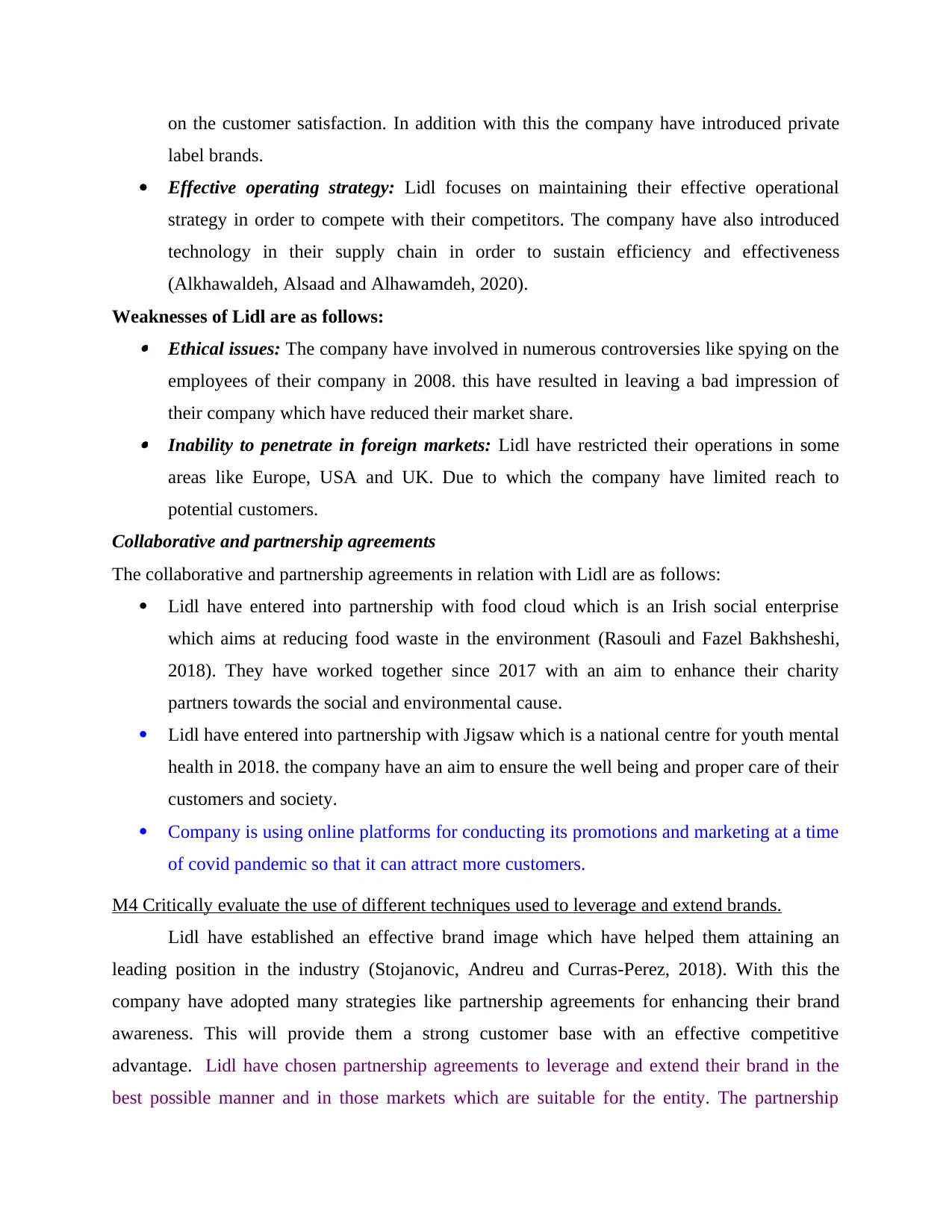
on the customer satisfaction. In addition with this the company have introduced private
label brands.
Effective operating strategy: Lidl focuses on maintaining their effective operational
strategy in order to compete with their competitors. The company have also introduced
technology in their supply chain in order to sustain efficiency and effectiveness
(Alkhawaldeh, Alsaad and Alhawamdeh, 2020).
Weaknesses of Lidl are as follows: Ethical issues: The company have involved in numerous controversies like spying on the
employees of their company in 2008. this have resulted in leaving a bad impression of
their company which have reduced their market share. Inability to penetrate in foreign markets: Lidl have restricted their operations in some
areas like Europe, USA and UK. Due to which the company have limited reach to
potential customers.
Collaborative and partnership agreements
The collaborative and partnership agreements in relation with Lidl are as follows:
Lidl have entered into partnership with food cloud which is an Irish social enterprise
which aims at reducing food waste in the environment (Rasouli and Fazel Bakhsheshi,
2018). They have worked together since 2017 with an aim to enhance their charity
partners towards the social and environmental cause.
Lidl have entered into partnership with Jigsaw which is a national centre for youth mental
health in 2018. the company have an aim to ensure the well being and proper care of their
customers and society.
Company is using online platforms for conducting its promotions and marketing at a time
of covid pandemic so that it can attract more customers.
M4 Critically evaluate the use of different techniques used to leverage and extend brands.
Lidl have established an effective brand image which have helped them attaining an
leading position in the industry (Stojanovic, Andreu and Curras-Perez, 2018). With this the
company have adopted many strategies like partnership agreements for enhancing their brand
awareness. This will provide them a strong customer base with an effective competitive
advantage. Lidl have chosen partnership agreements to leverage and extend their brand in the
best possible manner and in those markets which are suitable for the entity. The partnership
label brands.
Effective operating strategy: Lidl focuses on maintaining their effective operational
strategy in order to compete with their competitors. The company have also introduced
technology in their supply chain in order to sustain efficiency and effectiveness
(Alkhawaldeh, Alsaad and Alhawamdeh, 2020).
Weaknesses of Lidl are as follows: Ethical issues: The company have involved in numerous controversies like spying on the
employees of their company in 2008. this have resulted in leaving a bad impression of
their company which have reduced their market share. Inability to penetrate in foreign markets: Lidl have restricted their operations in some
areas like Europe, USA and UK. Due to which the company have limited reach to
potential customers.
Collaborative and partnership agreements
The collaborative and partnership agreements in relation with Lidl are as follows:
Lidl have entered into partnership with food cloud which is an Irish social enterprise
which aims at reducing food waste in the environment (Rasouli and Fazel Bakhsheshi,
2018). They have worked together since 2017 with an aim to enhance their charity
partners towards the social and environmental cause.
Lidl have entered into partnership with Jigsaw which is a national centre for youth mental
health in 2018. the company have an aim to ensure the well being and proper care of their
customers and society.
Company is using online platforms for conducting its promotions and marketing at a time
of covid pandemic so that it can attract more customers.
M4 Critically evaluate the use of different techniques used to leverage and extend brands.
Lidl have established an effective brand image which have helped them attaining an
leading position in the industry (Stojanovic, Andreu and Curras-Perez, 2018). With this the
company have adopted many strategies like partnership agreements for enhancing their brand
awareness. This will provide them a strong customer base with an effective competitive
advantage. Lidl have chosen partnership agreements to leverage and extend their brand in the
best possible manner and in those markets which are suitable for the entity. The partnership
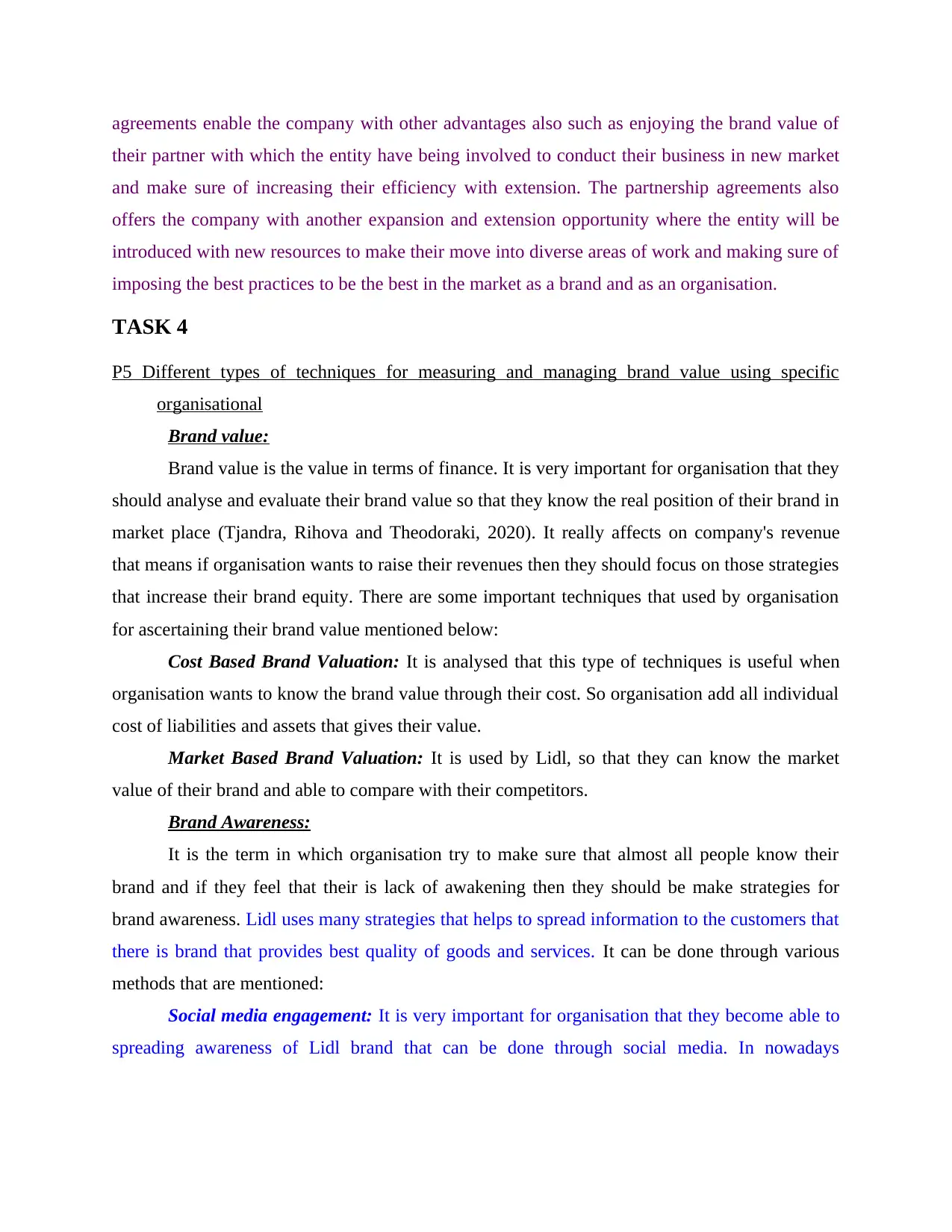
agreements enable the company with other advantages also such as enjoying the brand value of
their partner with which the entity have being involved to conduct their business in new market
and make sure of increasing their efficiency with extension. The partnership agreements also
offers the company with another expansion and extension opportunity where the entity will be
introduced with new resources to make their move into diverse areas of work and making sure of
imposing the best practices to be the best in the market as a brand and as an organisation.
TASK 4
P5 Different types of techniques for measuring and managing brand value using specific
organisational
Brand value:
Brand value is the value in terms of finance. It is very important for organisation that they
should analyse and evaluate their brand value so that they know the real position of their brand in
market place (Tjandra, Rihova and Theodoraki, 2020). It really affects on company's revenue
that means if organisation wants to raise their revenues then they should focus on those strategies
that increase their brand equity. There are some important techniques that used by organisation
for ascertaining their brand value mentioned below:
Cost Based Brand Valuation: It is analysed that this type of techniques is useful when
organisation wants to know the brand value through their cost. So organisation add all individual
cost of liabilities and assets that gives their value.
Market Based Brand Valuation: It is used by Lidl, so that they can know the market
value of their brand and able to compare with their competitors.
Brand Awareness:
It is the term in which organisation try to make sure that almost all people know their
brand and if they feel that their is lack of awakening then they should be make strategies for
brand awareness. Lidl uses many strategies that helps to spread information to the customers that
there is brand that provides best quality of goods and services. It can be done through various
methods that are mentioned:
Social media engagement: It is very important for organisation that they become able to
spreading awareness of Lidl brand that can be done through social media. In nowadays
their partner with which the entity have being involved to conduct their business in new market
and make sure of increasing their efficiency with extension. The partnership agreements also
offers the company with another expansion and extension opportunity where the entity will be
introduced with new resources to make their move into diverse areas of work and making sure of
imposing the best practices to be the best in the market as a brand and as an organisation.
TASK 4
P5 Different types of techniques for measuring and managing brand value using specific
organisational
Brand value:
Brand value is the value in terms of finance. It is very important for organisation that they
should analyse and evaluate their brand value so that they know the real position of their brand in
market place (Tjandra, Rihova and Theodoraki, 2020). It really affects on company's revenue
that means if organisation wants to raise their revenues then they should focus on those strategies
that increase their brand equity. There are some important techniques that used by organisation
for ascertaining their brand value mentioned below:
Cost Based Brand Valuation: It is analysed that this type of techniques is useful when
organisation wants to know the brand value through their cost. So organisation add all individual
cost of liabilities and assets that gives their value.
Market Based Brand Valuation: It is used by Lidl, so that they can know the market
value of their brand and able to compare with their competitors.
Brand Awareness:
It is the term in which organisation try to make sure that almost all people know their
brand and if they feel that their is lack of awakening then they should be make strategies for
brand awareness. Lidl uses many strategies that helps to spread information to the customers that
there is brand that provides best quality of goods and services. It can be done through various
methods that are mentioned:
Social media engagement: It is very important for organisation that they become able to
spreading awareness of Lidl brand that can be done through social media. In nowadays
⊘ This is a preview!⊘
Do you want full access?
Subscribe today to unlock all pages.

Trusted by 1+ million students worldwide
1 out of 16
Related Documents
Your All-in-One AI-Powered Toolkit for Academic Success.
+13062052269
info@desklib.com
Available 24*7 on WhatsApp / Email
![[object Object]](/_next/static/media/star-bottom.7253800d.svg)
Unlock your academic potential
Copyright © 2020–2025 A2Z Services. All Rights Reserved. Developed and managed by ZUCOL.




